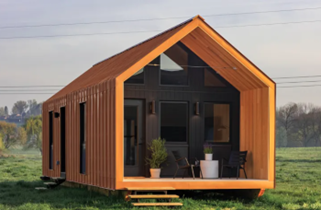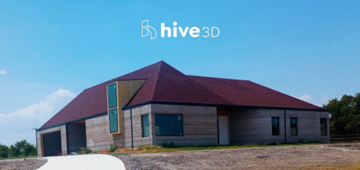The world faces a housing crisis. A scarcity of materials and labor relative to demand creates a dire need for more efficient allocations of resources. In the eyes of a developer, the goal is to maximize revenue relative to cost, ensuring structural integrity and code compliance, while mitigating overruns and delays.
Cost stands as the primary constraint in construction. Materials comprise the bulk of expenses, ranging from 40-70% of total cost for a project. Contracted costs, provided by contractors with request for proposals, emerge long after the design phase, meaning the bulk of material selections are made without definitive cost knowledge. With dramatic volatility in prices, the procurement process is fragmented and inefficient. Economies of scale are prevalent as scaled firms can output the same product with uniform materials at lower costs – sometimes achieving margins 5-10% higher than the rest of the industry.
"Rise Tower, built from a sustainable concrete alternative, will stand as the tallest structure in Latin America upon completion in 2026."
Legacy fragmentation
Regardless of scale, 30% of materials delivered to a commercial construction site end up as waste. With prices appreciating 38% since COVID-19, waste undermines the efforts of procurement teams. Furthermore, delivery times have more than doubled for prevalent materials since the pandemic. Longer lead times decrease pricing power and alter the course of a project, especially if a firm is not scaled enough to have a bulk of material inventory.
Another pain point is the usage of concrete in construction. Concrete has been imperative for the structural foundation of a building. It is the most widely used material in the world, and accounts for 8% of global carbon emissions. In 2018, 24 million tons of concrete were wasted in construction – contributing to roughly 73% of all construction waste.
Concrete is a material that is generally sourced locally due to its high cost of transportation. It is heavily exposed to price fluctuations and can contribute to the varying regional project costs which a procurement team cannot control.
Solution 1: Modular Construction
Modular construction is the practice of building projects off-site in a repetitive and procedural manner. The process is run by automated systems making exact measurements and reducing waste as a result. With assembly undertaken off-site, materials can be ordered in bulk on a predictable timeline.
Companies are executing modular practices commercially. Plant PreFab, a modular multi-family developer, raised $30 million of Series B funding in 2021. They aim to develop 10 to 30 story apartment buildings in mega-markets, adopting a hybrid modular approach by constructing bathrooms and kitchens off-site, and bedrooms, living rooms and hallways on-site. In 2016, Plant PreFab completed the 32 story, 363-unit “461 Dean Apartments” in Brooklyn, the largest modular building ever constructed upon completion.
DXA Studios has embraced a similar approach, implementing a ‘component linked construction’ practice. They build bathrooms and kitchens off-site while packaging modules for smaller components such as porches, walls, and headboards to be pieced together on-site.
Modular construction faces substantial obstacles, however. Challenges include transporting large pre-constructed structures, situating modular structures in dense urban areas, and training operators to use the novel methods associated with modular construction. In many situations, adoption costs far outweigh expected savings.
While it's improbable that entire commercial buildings will ever be built off-site, hybrid modular construction can still make a significant impact akin PlantPreFab and DXA Studios’ approach.
Considering that finishes (both interior and exterior) make up about 29% of the total cost, focusing on elements that can be easily transported and replicated industrially appears to be the most practical strategy.
solution 2: 3d printing
3D printing, a form of additive manufacturing, is recognized for its precision in using only the necessary amount of material for each structure. Additive manufacturing has potential to significantly reduce material usage, enhancing cost efficiency and sustainability when implemented effectively.
Hive3D, a Houston-based company, has 3D printed six homes utilizing primarily automated labor and a sustainable concrete alternative. This material, derived from FlyAsh, significantly reduces carbon emissions up to 92-99%. It eliminates the need to heat limestone, a key contributor to concrete's environmental footprint.
These homes, located in Lenar, were priced between $470,000 and $579,000, slightly above the area's average home cost of $459,932. Although initially costlier, the long-term benefits for homeowners are notable. Hive3D's sustainable concrete not only provides better insulation than wood, it enhances flood and mold resistance, offering greater durability and safety.
Beyond Hive3D's technique, numerous strategies have been introduced to develop sustainable concrete. For instance, in 2020, CEMEX launched Vertua, garnering significant success with sales exceeding 100,000 cubic meters in Columbia. Vertua is notably being used in the construction of the Rise Tower, the largest skyscraper in Latin America.
While it holds promise, 3D printing is rarely used for commercial construction in the U.S. There are major adoption hurdles with the technical knowledge for 3D printing strongly differing from that of traditional construction methods. Furthermore, the aesthetic output of large-scale 3D-fabrication is quite limited and can produce blistering final design products. With further technological innovation, however, these hurdles can be overcome.
The Road ahead
Real estate, design and construction is poised for a transformative shift in the next 5-10 years. Automation holds vast potential, but its application needs to be discerning. Achieving widespread efficiency demands a diverse range of solutions, integrating both the hardware discussed in this article and generative software applications. The complexity of the industry precludes a one-size-fits-all approach, but the innovations seen today are just the tip of the iceberg.



